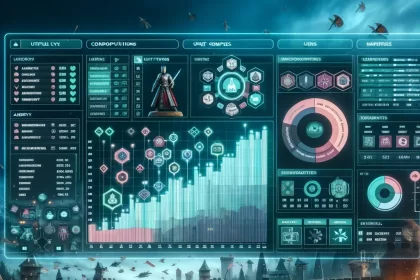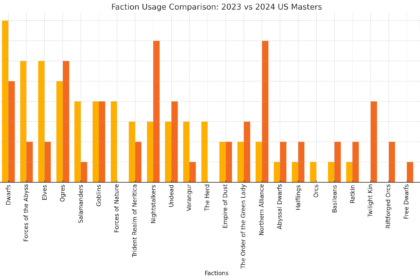The Australian Kings of War Masters tournament is a significant event that brings together the best players from across the country, all vying for the title of 2024 champion. In this article, I’ll dive into the pre-tournament analysis, examining faction representation, unit compositions, and key meta-defining elements like popular units and magic items. By looking at the data, I’ll uncover trends that give insight into how the competitive landscape is shaping up for this year’s Masters.
First, the typical spreadsheet with generated info from the parsed lists:
Faction Breakdown
The tournament features a diverse range of factions. The most represented factions include Ogres and Dwarfs, each fielding two players. All other factions have only a single representative. With only 16 lists, this represents a small sample size, especially compared to larger events like the UK Clash of Kings, which featured nearly 200 participants. This makes it tough to draw firm conclusions, but it does indicate a relatively balanced field, with no single faction dominating in numbers, highlighting the healthy diversity of the competitive meta.
| Faction | Count |
|---|---|
| Ogres | 2 |
| Dwarfs | 2 |
| The Order of the Green Lady | 1 |
| Salamanders | 1 |
| The Herd | 1 |
| Empire of Dust | 1 |
| Kingdoms of Men | 1 |
| Elves | 1 |
| Twilight Kin | 1 |
| Goblins | 1 |
| Nightstalkers | 1 |
| Ratkin | 1 |
| Varangur | 1 |
| Abyssal Dwarfs | 1 |
The wide variety of factions represented shows that players are comfortable experimenting with different playstyles and strategies, instead of consolidating around a perceived “strongest” army. However, given the limited number of participants, view these trends with caution as they may not fully represent broader meta shifts. Additionally, this tournament is being played under the existing Clash of Kings 2024 rules, not the upcoming rebalancing that has already been issued, which may influence players’ list choices differently compared to future events.
Unit Composition Breakdown
The average total number of units per army is between 13 and 15, aligning closely with other major tournaments like the US Masters, Aussie Clash of Kings, UK Masters, and Lonewolf GT, where average drops typically fall in the 13-14 range. For a more in-depth analysis on similar tournaments, refer to this post.
Notably, Andrew Goodman’s Dwarfs army fields 13 units, but maximizes unit strength at 27. He packs a lot of firepower (average expected damage of 83.8). Conversely, Matt Curtis’s Elves bring a lower drop count (11) but with a different distribution of strengths, focusing on speed and tactical flexibility. The average speed of his units is 7.5, and 45% are Nimble, enhancing their maneuverability on the battlefield.
These variations show that players are taking varied approaches to list-building, with some opting for smaller, elite forces while others choose large, multi-unit armies for broader board control. Here is a summary of average army characteristics based on the data:
| Attribute | Average |
|---|---|
| Total Units | 14.0 |
| Unit Strength | 24.7 |
| Scoring Units | 11.4 |
| Avg Speed | 6.5 |
| Nimble | 4.3 |
| Avg Defense | 4.5 |
| Nerve Pool | 220.1 |
| Shots to Six Nerve | 362.4 |
Magic Items Taken
I’m often fascinated by seeing the various magic items. Here is a summary of the most commonly taken magic items at the tournament:
| Magic Item | Count |
|---|---|
| Sir Jesse’s Boots of Striding | 6 |
| Staying Stone | 4 |
| Helm of the Drunken Ram | 4 |
| Conjurer’s Staff | 3 |
| Hammer of Measured Force | 3 |
The J-boots continue to be immensely popular as terrain mitigation, and the Staying Stone is a cheap anti-waiver tool for many lists. The eternal debate about whether the Hammer of Measured Force is a points trap or an essential tool continues, with 3 of 16 lists picking it here.
Standout Lists
Drawing firm conclusions from a field this small and this competitive is challenging. As I mentioned on Countercharge, predicting performance based on list-building alone is highly uncertain. However, Jeffrey Traish’s Abyssal Dwarf build stands out to me. It is surprisingly fast, versatile, and capable of packing a punch—strong in many areas without overcommitting to any single strategy. Adam Story’s Order of the Green Lady is also notable, with 10 drops (7 scoring) and a unit strength of 19. It’s extremely fast and could create match-up issues, especially in a slower, dwarf-heavy meta. However, its low drop count makes it unforgiving. If played well, as Marcelo demonstrated at US Masters, the Order of the Green Lady can be a formidable challenge. The key question is whether Adam can avoid mistakes and make a deep run.
Conclusion
The pre-tournament data for the 2024 Australian Kings of War Masters highlights a diverse and balanced meta. Players are experimenting with a variety of factions, units, and strategies. However, given the small sample size of only 16 lists, it’s important to hedge these conclusions, as they may not fully reflect broader meta trends seen in larger tournaments. While some classic units and magic items dominate in popularity, there is enough variation to show that no single strategy will easily reign supreme. The stage is set for an exciting and unpredictable competition, where adaptability will be key to victory.
I will follow up post-tournament to see how these pre-event analyses translated into results on the table. Stay tuned for more insights as I continue to break down the Kings of War meta!






